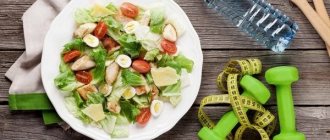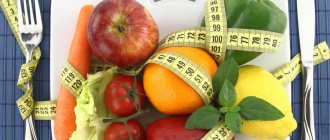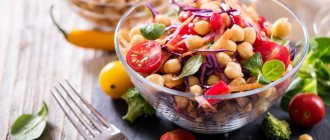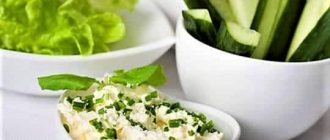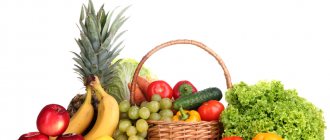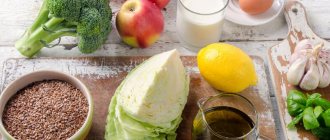Glycemic index of cereals
Cereals are important sources of energy, healthy dietary fiber, B vitamins (B1, B2, B3 (PP), B4, B5, B6 and B9), E, K and trace elements (calcium, sodium, phosphorus, magnesium, iron, manganese, zinc, cobalt, etc.) 1. Recommendations for creating a diet for people with diabetes advise making cereals, along with proteins, fats and “free” carbohydrates, the basis of the diet 2.
When choosing side dishes, it is worth considering the glycemic index of each individual variety of cereal.
Table of glycemic load and food index
The complete table of parameters for the most common foods containing carbohydrates is as follows.
| Products | GI | A portion | GN |
| Sweets | |||
| Honey | 87 | 1 tsp | 3 |
| Lollipops | 78 | 28 g | 22 |
| Snickers | 68 | 60 g (half) | 23 |
| Table sugar | 68 | 2 tsp | 7 |
| Strawberry jam | 51 | 2 tsp | 10.1 |
| Dark chocolate | 23 | 35 g | 4.4 |
| Baking and cereals | |||
| French baguette | 95 | 1 piece | 29.5 |
| Donut | 76 | 1 (about 75 g) | 24.3 |
| Waffle (homemade) | 76 | ! (about 75g) | 18.7 |
| Millet | 71 | 150 g | 26 |
| Regular loaf | 70 | 1 piece | 7.7 |
| Corasan | 67 | 1 medium | 17.5 |
| Muesli | 66 | 2/3 cup | 23.8 |
| Oatmeal (quick) | 65 | 1 glass | 13.7 |
| 100% rye bread | 65 | 1 piece | 8.5 |
| Rye bread | 65 | 1 (about 25g) | 11.1 |
| Blueberry muffin | 59 | 1 medium | 30 |
| Regular oatmeal | 58 | 1/2 cup | 6.4 |
| Wheat pita | 57 | one | 17 |
| Oat cookies | 55 | 1 large | 6 |
| Popcorn | 55 | 1 glass | 2.8 |
| Buckwheat | 55 | 150 g | 16 |
| Spaghetti | 53 | 180 g | 23 |
| Potato dumplings | 52 | 150 g | 23 |
| Bulgur | 46 | 150 g | 12 |
| Vanilla sponge cake with vanilla glaze | 42 | 1 piece | 16 |
| Chocolate sponge cake with chocolate icing | 38 | 1 piece | 12.5 |
| Dumplings | 28 | 100 g | 6 |
| Beverages | |||
| Cola | 63 | 330 ml | 25.2 |
| Orange juice | 57 | 1 machine | 14.25 |
| carrot juice | 43 | 1 glass | 10 |
| Cocoa with milk | 51 | 1 glass | 11.7 |
| Grapefruit juice | 48 | 1 glass | 13.4 |
| Pineapple juice | 46 | 1 glass | 14.7 |
| Soy milk | 44 | 1 glass | 4 |
| Apple juice | 41 | 1 glass | 11.9 |
| Tomato juice | 38 | 1 glass | 3.4 |
| Legumes | |||
| Lima beans | 31 | 1 glass | 7.4 |
| Chickpeas | 31 | 1 glass | 13.3 |
| Lentils | 29 | 1 glass | 7 |
| Regular beans | 27 | 1 glass | 7 |
| Soya beans | 20 | 1 glass | 1.4 |
| Peanut | 13 | 1 glass | 1.6 |
| Vegetables | |||
| Carrot | 92 | 1 medium | 1 |
| Beet | 64 | 1 medium | 9.6 |
| Corn | 55 | 1 glass | 61.5 |
| Green pea | 48 | 1/2 cup | 3.4 |
| Tomato | 38 | 1 medium | 1.5 |
| Broccoli | 0 | 1/2 cup (boiled) | 0 |
| Cabbage | 0 | 1/2 cup (boiled) | 0 |
| Celery | 0 | 60 g | 0 |
| Cauliflower | 0 | 100g (1 cup) | 0 |
| Green bean | 0 | 1 glass | 0 |
| Mushrooms | 0 | 70 g | 0 |
| Spinach | 0 | 1 glass | 0 |
| Fruits | |||
| Watermelon | 72 | 1 cup pulp | 7.2 |
| A pineapple | 66 | 1 glass | 11.9 |
| Cantaloupe | 65 | 170 g | 7.8 |
| Canned apricots | 64 | 1 glass | 24.3 |
| Raisin | 64 | 43g | 20.5 |
| Canned peach | 58 | 262g (1 cup) | 28.4 |
| Kiwi | 58 | one | 5.2 |
| Bananas | 51 | 1 medium | 12.2 |
| Mango | 51 | 160 g | 12.8 |
| Orange | 48 | one | 7.2 |
| Canned pears | 44 | 250 g | 12.3 |
| Grape | 43 | 1 glass | 6.5 |
| Strawberry | 40 | 1 glass | 3.6 |
| Apples | 39 | 1 medium without skin | 6.2 |
| Pears | 33 | 1 medium | 6.9 |
| Dried apricots | 32 | 1 glass | 23 |
| Prunes | 29 | 1 glass | 34.2 |
| Peaches | 28 | 1 medium | 2.2 |
| Grapefruit | 25 | 1/2 medium | 2.8 |
| Plums | 24 | one large | 1.7 |
| Cherries | 22 | 1 glass | 3.7 |
| Nuts | |||
| Cashew | 22 | ||
| Almond | 0 | ||
| Hazelnut | 0 | ||
| Macadamia | 0 | ||
| Pecan | 0 | ||
| Walnut | 0 | ||
| Dairy | |||
| Low fat ice cream | 47 | 1/2 cup | 9.4 |
| Milk pudding | 44 | 1/2 cup | 8.4 |
| Milk | 40 | 1 glass | 4.4 |
| Regular ice cream | 38 | 1/2 cup | 6 |
| Yogurt (without additives) | 36 | 1 glass | 6.1 |
* GI and GL data for common foods such as rice and potatoes, as well as all protein and fatty foods, are discussed separately below.
** The table shows average values, especially when it comes to complex dishes, such as baked goods.
Glycemic index - what is it?
The glycemic index (GI) is a ranking of carbohydrates on a scale of 0 to 100 based on how much they raise your blood sugar (glucose) levels after a meal. The standard in this classification is glucose, which has a GI of 100.
High GI foods are quickly absorbed, digested, absorbed and metabolized in the gastrointestinal tract. They lead to noticeable fluctuations in blood sugar (glucose) levels. Low GI foods cause less intense and slower increases in glucose and insulin levels.
Grinding, fine grinding, prolonged cooking, and treatment with auxiliary substances during the preparation of cereals can significantly increase its GI.
Low glycemic index foods
The easiest way to choose foods with a low glycemic index is a table that lists all fruits, vegetables, berries and grains. Fish, eggs and meat do not contain carbohydrates, have a zero index and therefore are not indicated in such tables. They are recommended to be included in the diet, but with one caveat: they should not contain a lot of fat, since it also increases the activity of the pancreas. By combining low-glycemic index vegetables and fruits with protein foods, you can get the nutrients you need without increasing your overall calorie intake or GI score.
Rice. 3
Table 1: Cereals, pasta with low glycemic index.
| The product's name | Glycemic index |
| Brown rice | 45 |
| Whole grain toast bread (toasted) | 45 |
| Whole grain breakfast cereal (no sweeteners, honey or added fruit) | 43 |
| Buckwheat | 40 |
| Cooked pasta (al dente) without sauce or oil | 40 |
| Black rice (wild) | 35 |
| Chickpea grains, cooked | 35 |
| Cooked beans | 35 |
| Chinese noodles without adding sauce or seasonings | 35 |
| Sesame grains | 35 |
| Bean grain | 34 |
| Bean flaps and pods | 30 |
| Lentils, including yellow ones | 30 |
| Green lentils | 25 |
| Golden beans | 25 |
| Bran any | 15 |
| Soybeans | 15 |
| Soy flour | 25 |
Products made from grains and flour have the highest GI values in the table, but this does not mean that their consumption should be reduced. They contain fiber, which is necessary for the normal functioning of the gastrointestinal tract, so you should abandon them in favor of products with a lower GI only in case of exacerbation of diseases of the pancreas, stomach and intestines.
White flour baked goods and baked goods do not contain fiber, so their glycemic index is much higher than low and even average values. The inclusion of such products in the diet is possible only in combination with special additives that can reduce the glycemic index of products: fiber, rye or wheat bran. They can be replaced with more modern and easy-to-use sources of dietary fiber, such as SmartFiber soluble powder supplement.
Table 2: Low Glycemic Index Vegetables and Greens
| The product's name | Glycemic index |
| Canned green peas | 45 |
| Fresh green peas | 35 |
| Fresh carrots | 30 |
| Carrot juice without added sugar | 40 |
| Fresh tomato | 30 |
| Dried tomato | 34 |
| Tomato juice | 33 |
| Fresh beets, not boiled | 30 |
| Fresh garlic | 30 |
| Artichoke | 20 |
| Eggplant | 20 |
| Cabbage, cauliflower, Brussels sprouts and broccoli | 15 |
| Celery (stalks, greens) | 15 |
| Chilli | 15 |
| Fresh cucumber | 15 |
| Onions and leeks | 15 |
| Zucchini | 15 |
| Mushrooms | 15 |
| Asparagus | 15 |
| Spinach | 15 |
| Olives | 15 |
| Leaf lettuce | 9 |
| Parsley, dill, cilantro, basil, oregano | 5 |
Despite the low GI, some vegetables, herbs and spices should not be used too often when creating a menu, especially if you have digestive problems. Potatoes are not among the vegetables with a low or even medium GI. This popular vegetable has high indicators: boiled in its jacket it is 65 units, baked 70 units, and the indicators for fried potatoes and mashed potatoes are 95 and 90 units, respectively.
Table 3: Fruits, berries, juices, roots and preparations made from them with a low glycemic index
| The product's name | Glycemic index |
| Cranberries without heat treatment | 47 |
| Grapefruit | 30 |
| Grapefruit juice without sugar | 45 |
| Orange | 35 |
| Orange fresh | 45 |
| Grape | 45 |
| Dried apricots | 40 |
| Fresh apple | 35 |
| Fresh plum | 35 |
| Dried plums (prunes) | 40 |
| Nectarine and peach | 34 |
| Pomegranate | 34 |
| Fresh cherries with pits | 32 |
| Fresh cherries without pits | 25 |
| Apricot | 30 |
| Mandarin | 30 |
| passion fruit | 30 |
| Garden berries - cherries, raspberries, red currants, gooseberries, wild strawberries and strawberries | 25 |
| Blackberry | 20 |
| Fresh pear | 30 |
| Blueberries, blueberries, lingonberries | 30 |
| Rhubarb | 15 |
| Avocado | 10 |
| Berry jam without sugar | 30 |
| Compote of fruits and berries without sugar | 34 |
| Ginger | 15 |
On average, the glycemic index of fruits is slightly higher than that of vegetables and herbs. This is explained by the fact that fruits, berries and fruits with a low glycemic index still contain carbohydrates. The GI value may vary depending on how the product is processed. For example, the index of fresh cherries with pits is 32, while for pitted cherries it is 7 points lower. If you want to reduce the index to a minimum, for preparing compotes and other dishes that use fresh cherries, it is better to first remove the pit from them.
When choosing fruits and berries for a diet, focusing only on GI is not entirely correct. For example, ginger, which has the lowest GI values, is strictly contraindicated for diseases of the pancreas (acute pancreatitis, diabetes mellitus), as it activates the secretion of pancreatic secretions. Therefore, if you need to follow a low GI diet against the background of glandular diseases, you should not use it. The same applies to citrus fruits and some berries with small seeds, sauces (Dijon mustard, soy sauce, pesto sauce) - they can irritate the digestive tract, increase pain, bloating and other unpleasant symptoms.
Almost all dairy products, including cow's milk, soy and almond milk, natural and soy yogurt, low-fat cottage cheese and tofu, have a low GI, so they can be safely included in the diet.
Wide variability in the glycemic index of rice and potatoes
What is the GI of rice and potatoes? This question is often asked by both scientists and people far from science. It's not easy to answer.
The fact is that the data on these two simple food products varies so much that it is almost impossible to give an average value.
Thus, the glycemic index of rice can range from 54 to 132, and of potatoes - from 67 to 158.
Why are the GI data for rice and potatoes so different?
Because the content of amylose and amylopectin varies in different varieties. The more amylose, the lower the glycemic index.
There are 4 main varieties of rice:
- long grain;
- medium grain;
- short grain;
- sweet or sticky (commonly used to make sauces in Asian restaurants).
Sweet rice contains no amylose at all. And its GI is maximum. Long-grain varieties, for example, Basmani, have the most amylose, and therefore their GI is minimal.
Additionally, each of these rice varieties can be white or brown. Brown always has a lower GI than white.
So, if we are talking about the popular Basmani rice, then its white form has a glycemic index of 83. The exact GI of brown Basmani has not yet been established, but scientists suggest that it is minimal, that is, about 54.
You can read more about how a grain of rice works and how its consumption affects weight loss in this article.
The situation is similar with potatoes. Different varieties have different amylose to amylopectin ratios, and therefore different GI values.
Moreover, young potatoes always have a lower glycemic index than more mature potatoes of the same variety. This is due to the fact that as the tubers mature, they contain less and less amylose and more and more amylopectin.
What nutrition principles should diabetics follow?
Some nutrition experts believe that people with diabetes should pay attention to both the glycemic index and glycemic load. This will avoid sudden spikes in blood sugar levels.
The American Diabetes Association, on the other hand, notes that the total amount of carbohydrates in a food, not its GI or glycemic load, is the strongest predictor of how blood sugar will fare. Additionally, some nutritionists also believe that focusing on the glycemic index and glycemic load adds an unnecessary level of complexity when choosing what to eat.
Conclusion : Following low glycemic index eating guidelines may be beneficial for people with diabetes. But achieving and maintaining a healthy weight is more important for your blood sugar levels and overall health.
Interaction between GN and GI
If the GL is the amount of carbohydrates in a food, then the glycemic index is the rate at which the carbohydrates contained in a particular food increase blood glucose levels.
Therefore, the GL and GI indicators of one product may be different. For example, carrots have a high GI, because the carbohydrates in its composition are quickly absorbed into the blood. But at the same time, the GL of carrots is low because it contains few carbohydrates. Another example: a watermelon and a bun have the same high GI - approximately 75. When calculating the GI, it turns out that the watermelon contains 6 g of carbohydrates (per 100 g of product), and the bun contains about 30. This means that with an equal jump in the level glucose in the blood, the body will receive more carbohydrates with a bun. This is the difference between GL and GI.
Thus, to organize proper nutrition and control sugar levels, it is important to take into account not only the GI of the product, but also its GL.
When creating a diet, it is important not to confuse the glycemic index with the glycemic load, since the latter is fundamentally different from the former. Controlling GBV is important primarily for professional athletes and people who want to lose excess weight. Competently drawing up a nutrition plan based on GN will help both of them achieve maximum results.
